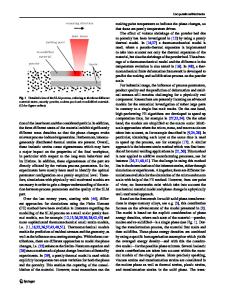A Fundamental Study of Laser Transformation Hardening
- PDF / 1,578,706 Bytes
- 11 Pages / 603.28 x 788 pts Page_size
- 10 Downloads / 336 Views
I.
INTRODUCTION
DUEto the recent development of high-power, continuouswave CO2 lasers, the laser surface treatment of engineering materials has drawn a great deal of attention. One important area of this new surface-treatment technology is laser transformation hardening. With the use of beam integrators or oscillators the energy of the laser beam can be uniformly distributed over a relatively large area, e.g., 12 mm • 12 mm square. Such uniform laser beams, usually square or rectangular, are most ideal for surface transformation hardening due to the uniform depth of the hardened case and the high coverage rate that can be obtained. The analytical equation describing the steady-state, threedimensional heat flow in a moving semi-infinite workpiece subjected to a stationary square (or rectangular) heat source was first derived by Jaeger in 1943.1'2 The major assumptions made were equivalent to: (1) no surface heat loss due to convection or radiation, (2) constant thermal properties, and (3) constant surface absorptivity. More recently Arata et al 3 have also derived analytical equations for the same heat flow problem. Their equations, however, allow the Gaussian as well as the uniform heat distribution to be considered. Since both Jaeger's and Arata's equations involve the integration of the error function from zero to infinity, extensive numerical computations are required in the heat flow calculation.3'4 By assuming one-dimensional heat flow, Greenwald et al s have derived a simple analytical equation and thus have avoided numerical computations. Although circular laser beams are usually not used for surface transformation hardening, it is worth noting that analytical heat flow equations have been derived by Cline et al, 6 Yessik,7 and Arata et al, 3 and computer heat-flow models have been developed by Mazumder et al 8 and Kou et a/9'1~ for calculating heat flows due to a circular laser beam. SINDO KOU, Associate Professor, and Y. P. LE, Graduate Student, are with the Department of Metallurgical Engineering and Materials Science; and D. K. SUN, Graduate Student, is with the Department of Physics; all are with Carnegie-Mellon University, Pittsburgh, PA 15213. Manuscript submitted May 6, 1982. METALLURGICALTRANSACTIONS A
The present study deals with the heat flow and solid-state phase transformations during the laser transformation hardening of 1018 steel. A finite-difference computer model is developed to simulate the heat flow during laser transformation hardening, and to evaluate the validity of the assumptions upon which the analytical solutions of heat flow are based. Furthermore, experimental surface transformation hardening is carried out using a square laser beam of uniform energy distribution, and the results are analyzed with the help of the computer model.
II.
EXPERIMENTAL PROCEDURES
The surface heat-treatment experiment was carried out at AVCO Everett Research Laboratory. The power source used was an AVCO high-power, continuous-wave CO2 laser. The maximum power capacity was 15 kW, and the wave length
Data Loading...










